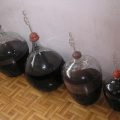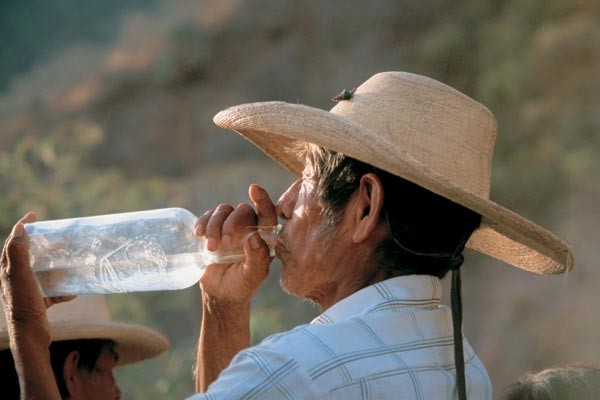 History of TequilaTequila Jr.a representative of a very ancient family of Mexican drinks. As, according to an apocryphal legend, "before Eve there was Lilith", so before tequila there was mescal. And before mescal - the native octli, or pulque. The Aztec Indians drank this intoxicating brew for centuries and would have drunk it for just as long if the Spaniards had not appeared in the New World in 1520. The conquistadors found the state of local alcohol production depressing. The Indians did not know grapes; they extracted sweet juice from a strange plant by piercing the wild fruit with a reed, after which they allowed it to ferment. This foaming drink, as strong as beer, was consumed by both young and old during religious ceremonies. The plant itself was considered a gift from heaven and a tree of miracles, the personification of an early incarnation of the goddess Mayahuel, who had 400 breasts to feed all four hundred of her children. The Spaniards needed a strong drink not so much because of their harsh natures, but because of their habit of not trusting water. When it was necessary to drink water, for example, in the absence of wine, it was disinfected by adding strong alcohol, barrels of which stood on ships precisely as lysol, and not as fuel for pirate feasts. Here in a foreign land, the Europeans had no choice, and a few years after landing on the Aztec coast, the low-alcohol local pulque began to be distilled to increase the strength. The resulting drink was given the name of the local plant, which the Spaniards remade in their own way and began to call "mezcal wine", or simply "mezcal". Thus, the fusion of two cultures created a new drink - from a local plant and European experience. And if we do not forget that the Arabs taught the Spaniards the method of distillation - then all three civilizations.
History of TequilaTequila Jr.a representative of a very ancient family of Mexican drinks. As, according to an apocryphal legend, "before Eve there was Lilith", so before tequila there was mescal. And before mescal - the native octli, or pulque. The Aztec Indians drank this intoxicating brew for centuries and would have drunk it for just as long if the Spaniards had not appeared in the New World in 1520. The conquistadors found the state of local alcohol production depressing. The Indians did not know grapes; they extracted sweet juice from a strange plant by piercing the wild fruit with a reed, after which they allowed it to ferment. This foaming drink, as strong as beer, was consumed by both young and old during religious ceremonies. The plant itself was considered a gift from heaven and a tree of miracles, the personification of an early incarnation of the goddess Mayahuel, who had 400 breasts to feed all four hundred of her children. The Spaniards needed a strong drink not so much because of their harsh natures, but because of their habit of not trusting water. When it was necessary to drink water, for example, in the absence of wine, it was disinfected by adding strong alcohol, barrels of which stood on ships precisely as lysol, and not as fuel for pirate feasts. Here in a foreign land, the Europeans had no choice, and a few years after landing on the Aztec coast, the low-alcohol local pulque began to be distilled to increase the strength. The resulting drink was given the name of the local plant, which the Spaniards remade in their own way and began to call "mezcal wine", or simply "mezcal". Thus, the fusion of two cultures created a new drink - from a local plant and European experience. And if we do not forget that the Arabs taught the Spaniards the method of distillation - then all three civilizations.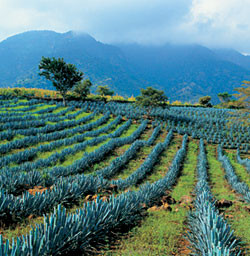 Tequila drinkBefore tequila is refined,refined mescal, there was one step left, but it was not taken for three centuries. In the second half of the 19th century, the product from the area around the city of Tequila in the state of Jalisco - "mezcal from Tequila" began to be simply called "tequila", just as brandy from the famous region of France became simply cognac. The first written mention of tequila belongs to the French traveler Ernest de Vigneaux. However, several decades passed before the common noun entered into widespread use. Pica in the heart In Mexico, 136 species of agave grow, only one of them - blue - is used to make tequila. To ensure that its reserves do not run out, succulent plantations are constantly renewed. Agave is a succulent, not a cactus, as many people believe! The main difference is that the plant accumulates moisture in its leaves, and not in its stems, like a cactus. Small shoots obtained from adult plants are planted in rows in cultivated gardens before the rainy season - potreros - 3-4 thousand per hectare. But before the core of the agave - pica, shaped like a pineapple, ripens and fills with juice, 8 to 12 years must pass. To make it more massive, flower shoots are cut off during the flowering period - so nutrients are not spent on the formation and maturation of seeds. According to producers, this "AB; » economically profitable, but from the point of view of biologists, it causes double harm: the population of long-nosed bats that pollinate the agave flowers decreases, which in turn reduces the number of wild plants needed for industrial purposes. The appearance of reddish spots on the agave leaves is a sign that the fruit has accumulated a sufficient amount of sweet juice, and the himadores, the harvesters, can begin work. They chop off the leaves, and then use long "koa" - sharpened shovels - to cut down the fruit. By the way, not everyone can work as a himador: only physically strong men, because one pick weighs up to 100 kilograms, and in a day they have to process and drag up to a ton of fruit to a tractor. Himadores are never idle. The harvest is collected all year round.
Tequila drinkBefore tequila is refined,refined mescal, there was one step left, but it was not taken for three centuries. In the second half of the 19th century, the product from the area around the city of Tequila in the state of Jalisco - "mezcal from Tequila" began to be simply called "tequila", just as brandy from the famous region of France became simply cognac. The first written mention of tequila belongs to the French traveler Ernest de Vigneaux. However, several decades passed before the common noun entered into widespread use. Pica in the heart In Mexico, 136 species of agave grow, only one of them - blue - is used to make tequila. To ensure that its reserves do not run out, succulent plantations are constantly renewed. Agave is a succulent, not a cactus, as many people believe! The main difference is that the plant accumulates moisture in its leaves, and not in its stems, like a cactus. Small shoots obtained from adult plants are planted in rows in cultivated gardens before the rainy season - potreros - 3-4 thousand per hectare. But before the core of the agave - pica, shaped like a pineapple, ripens and fills with juice, 8 to 12 years must pass. To make it more massive, flower shoots are cut off during the flowering period - so nutrients are not spent on the formation and maturation of seeds. According to producers, this "AB; » economically profitable, but from the point of view of biologists, it causes double harm: the population of long-nosed bats that pollinate the agave flowers decreases, which in turn reduces the number of wild plants needed for industrial purposes. The appearance of reddish spots on the agave leaves is a sign that the fruit has accumulated a sufficient amount of sweet juice, and the himadores, the harvesters, can begin work. They chop off the leaves, and then use long "koa" - sharpened shovels - to cut down the fruit. By the way, not everyone can work as a himador: only physically strong men, because one pick weighs up to 100 kilograms, and in a day they have to process and drag up to a ton of fruit to a tractor. Himadores are never idle. The harvest is collected all year round.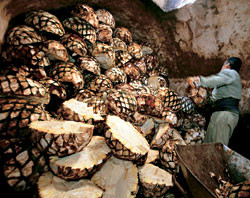 The fruits are then taken to the factory where they are awaitedovens. The halved or quartered peaks are placed in ovens or autoclaves, where they simmer at a temperature of 60-80°C for 12 to 72 hours. This process is necessary to break down inulin into fructose and glucose, which are easier to ferment, dissolve in water and, therefore, are easier to remove from the fibers. However, it is dangerous to speed it up - the high temperature can lead to the onset of caramelization of the agave sugar. After this, the agave pieces are allowed to cool (in industrial production, not for long), they are crushed in special mills, the pulp is pressed out, and then the juice, containing about 12% sugar, is placed in steel fermentation tanks (artisanal factories sometimes leave the pulp undivided). 7-10 days of fermentation at a temperature of 30-40°C transform the sweet mass into a kind of pulque with an alcohol content of 4-7 degrees. From this brew, as in the times of the conquistadors, "mescal wine" is distilled. Tequila, unlike mescal, undergoes mandatory double distillation, and from the second distillation only the middle part of the distilled product - the so-called "el corazon", the heart - goes into production. Sometimes triple distillation is carried out, but many connoisseurs are against "super-purification", believing that it leads to a thinning of the agave aroma.
The fruits are then taken to the factory where they are awaitedovens. The halved or quartered peaks are placed in ovens or autoclaves, where they simmer at a temperature of 60-80°C for 12 to 72 hours. This process is necessary to break down inulin into fructose and glucose, which are easier to ferment, dissolve in water and, therefore, are easier to remove from the fibers. However, it is dangerous to speed it up - the high temperature can lead to the onset of caramelization of the agave sugar. After this, the agave pieces are allowed to cool (in industrial production, not for long), they are crushed in special mills, the pulp is pressed out, and then the juice, containing about 12% sugar, is placed in steel fermentation tanks (artisanal factories sometimes leave the pulp undivided). 7-10 days of fermentation at a temperature of 30-40°C transform the sweet mass into a kind of pulque with an alcohol content of 4-7 degrees. From this brew, as in the times of the conquistadors, "mescal wine" is distilled. Tequila, unlike mescal, undergoes mandatory double distillation, and from the second distillation only the middle part of the distilled product - the so-called "el corazon", the heart - goes into production. Sometimes triple distillation is carried out, but many connoisseurs are against "super-purification", believing that it leads to a thinning of the agave aroma.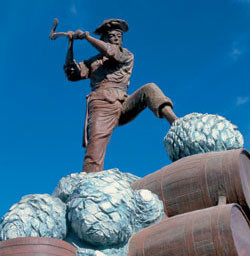 Under the statue of the JimadorOpen-air museumстал городок с некогда ничего не говорящим именем Текила. Теперь сюда из Гвадалахары курсирует туристический «Текила—экспресс». При въезде в город вас встречает статуя — не девушки с веслом, а химадора с лопатой-коа в руке. Здесь производители напитка гостеприимно открыли двери своих музеев, по совместительству играющих роль дегустационных залов. Разнообразию же одноименного напитка в Текиле нет конца. В последний день ноября в городе открывается Национальная ярмарка текилы, представляющая собой нескончаемый праздник для публики с петушиными боями, с мексиканским родео — charreadas, с огненными шоу и серенадами бродячих трупп. Но главный «центр тяжести» городка с населением 35 тысяч человек расположен за его пределами. Здесь, на склонах потухшего вулкана Текила, растет более половины всей мексиканской агавы — ведь Tequilana weber azul любит высоту. Максимальных размеров и спелости она достигает на высоте от полутора километров над уровнем моря.Предмет национальной гордости Текиле посвящали стихи и поэмы не только местные исполнители в широких шляпах, но и рок-группы, например The Eagle. Окруженная таким вниманием, она просто обречена была стать мексиканской легендой, породившей и повышенный спрос. Если же перемножить гектары земли, отданной под плантации агавы, на среднюю плотность посадок, то выясняется, что на каждого жителя страны приходится как минимум 2–3 голубые агавы, растущие в ожидании часа, когда они станут национальным напитком. А если вспомнить, что из одной пики получают несколько бутылок текилы (расчет таков: 7 килограммов мякоти плода дают литр текилы), становится ясно, что производство давно приобрело масштаб, выходящий за пределы страны. Особенно это заметно в Гвадалахаре — столице штата Халиско. Почти каждый его житель связан с производством местного напитка. В общей же сложности в Мексике, так или иначе, «работают на текилу» 300 тысяч человек. Даже в местном университете открыто отделение, выпускающее инженеров-технологов по перегонке текилы. Этот факультет — словно ответный знак благодарности, ведь 200 лет назад именно налог, которым местное правительство обложило фабрики мескаля, позволил открыться этому вузу. Популярность текилы, вышедшая за пределы страны, привела к необходимости защищать и название, и методы производства напитка. Что и было сделано правительством Мексики в 70-х годах прошлого века. Более того, выращивать агаву и делать из нее текилу разрешалось только в 5 штатах: Халиско, Гуанахуато, Мичоакан, Наярит и Тамаулипас. Сегодня на территории этих штатов открыто чуть больше полусотни текилокурен. На этикетке каждой бутылки они ставят значок CRT (Совет по надзору за производством текилы) и аббревиатуру NOM (Государственный стандарт качества Мексики) с номером, присвоенным торговой палатой конкретному предприятию, что является гарантией качества продукта.Кроме того, на бутылке под торговой маркой должно значиться tequila (а не spirit of agava) и должен быть обозначен ее тип: blanco (plata), joven (gold), reposado или anejo. У текилы, изготовленной исключительно из голубой агавы, на этикетке будет присутствовать 100% agave. Если такой надписи нет, перед вами — текила mixto. И последние штрихи: Hecho en Mexico означает, что продукт произведен и бутилирован на исторической родине, в Мексике. На сорта mixto это требование не распространяется. Надпись Hecho a mano — «ручное», кустарное, производство — говорит о традиционном, несокращенном цикле изготовления. Вкус текилы из бутылки с таким ярлыком наверняка окажется богатым, и это непременно скажется на ее цене. Сорта напиткаBlanco, или plata (silver) — беспримесная текила, бутилированная сразу после дистилляции или выдержанная в бочках до 30 суток. Основа всех остальных сортов напитка. В наибольшей степени передает аромат агавы, особенно если 100% agave. Joven abocado («разлитая молодой»), она же oro (золотая) — хит продаж во всем мире, включая Россию, — ароматизированная, с добавкой карамели для придания цвета, текила mixto. В высшей степени удачный ход маркетологов — и хорошее начало знакомства с напитком. Reposado — текила, которую после дистилляции на несколько месяцев помещают в деревянные бочки (обычно дубовые) для придания дополнительного аромата и цвета. Многие производители используют бочки из-под виски или бренди. Вкус текилы reposado более острый, «с перчинкой». Некоторые любители считают, что в текиле аромат агавы скрадывается. Самый популярный в Мексике сорт текилы. Anejo («аньехо», то есть выдержанная), хранящаяся в дубовых бочках текила обычно от года до десяти лет. Поскольку длительное хранение текилы в бочках сопряжено с опасностью, что дерево перебьет исходный вкус агавы, после нескольких лет текилу переливают в емкости из нержавеющей стали. Вкус текилы anejo насыщенный, древесный, «с дымком». При выборе сорта текилы, может быть, главное — не возраст и тип производства, а процентное содержание сырья агавы. Текила, изготовленная из агавы без примесей иного сахара, как более аутентичная, должна быть названа лучшим выбором. Однако к такой текиле, как к 99-процентному шоколаду, нужно подходить постепенно. Сорта mixto, в которых вкус агавы приглушен иным сахаром, в основном тростниковым, доступнее неподготовленному вкусу. Именно сортам mixto текила обязана своим взлетом популярности в США в 1980-е годы. Во многом он обязан гибкости мексиканского бюро стандартов (Normas Oficial Mexicana), специалисты которого, идя навстречу пожеланиям рынка, в 1978 году снизили планку минимального содержания сока агавы с 70 процентов (стандарт 1964 года) до 51. Североамериканские знатоки рекомендуют хранить содержимое однажды откупоренной бутылки текилы не более 1—2 месяцев, иначе она начнет терять свои вкусовые свойства. Поскольку гражданина России заподозрить в таком нечеловеческом самообладании трудно, мы посоветуем не выпивать бутылку текилы за один раз и в одиночестве. Во-первых, даже текила, изготовленная исключительно из агавы и прошедшая двойную дистилляцию, похмельным синдромом не отличается от виски или джина, а во-вторых, этот напиток, как писал поэт Альваро Мутис, создан для дружеского диалога, который не терпит спешки.
Under the statue of the JimadorOpen-air museumстал городок с некогда ничего не говорящим именем Текила. Теперь сюда из Гвадалахары курсирует туристический «Текила—экспресс». При въезде в город вас встречает статуя — не девушки с веслом, а химадора с лопатой-коа в руке. Здесь производители напитка гостеприимно открыли двери своих музеев, по совместительству играющих роль дегустационных залов. Разнообразию же одноименного напитка в Текиле нет конца. В последний день ноября в городе открывается Национальная ярмарка текилы, представляющая собой нескончаемый праздник для публики с петушиными боями, с мексиканским родео — charreadas, с огненными шоу и серенадами бродячих трупп. Но главный «центр тяжести» городка с населением 35 тысяч человек расположен за его пределами. Здесь, на склонах потухшего вулкана Текила, растет более половины всей мексиканской агавы — ведь Tequilana weber azul любит высоту. Максимальных размеров и спелости она достигает на высоте от полутора километров над уровнем моря.Предмет национальной гордости Текиле посвящали стихи и поэмы не только местные исполнители в широких шляпах, но и рок-группы, например The Eagle. Окруженная таким вниманием, она просто обречена была стать мексиканской легендой, породившей и повышенный спрос. Если же перемножить гектары земли, отданной под плантации агавы, на среднюю плотность посадок, то выясняется, что на каждого жителя страны приходится как минимум 2–3 голубые агавы, растущие в ожидании часа, когда они станут национальным напитком. А если вспомнить, что из одной пики получают несколько бутылок текилы (расчет таков: 7 килограммов мякоти плода дают литр текилы), становится ясно, что производство давно приобрело масштаб, выходящий за пределы страны. Особенно это заметно в Гвадалахаре — столице штата Халиско. Почти каждый его житель связан с производством местного напитка. В общей же сложности в Мексике, так или иначе, «работают на текилу» 300 тысяч человек. Даже в местном университете открыто отделение, выпускающее инженеров-технологов по перегонке текилы. Этот факультет — словно ответный знак благодарности, ведь 200 лет назад именно налог, которым местное правительство обложило фабрики мескаля, позволил открыться этому вузу. Популярность текилы, вышедшая за пределы страны, привела к необходимости защищать и название, и методы производства напитка. Что и было сделано правительством Мексики в 70-х годах прошлого века. Более того, выращивать агаву и делать из нее текилу разрешалось только в 5 штатах: Халиско, Гуанахуато, Мичоакан, Наярит и Тамаулипас. Сегодня на территории этих штатов открыто чуть больше полусотни текилокурен. На этикетке каждой бутылки они ставят значок CRT (Совет по надзору за производством текилы) и аббревиатуру NOM (Государственный стандарт качества Мексики) с номером, присвоенным торговой палатой конкретному предприятию, что является гарантией качества продукта.Кроме того, на бутылке под торговой маркой должно значиться tequila (а не spirit of agava) и должен быть обозначен ее тип: blanco (plata), joven (gold), reposado или anejo. У текилы, изготовленной исключительно из голубой агавы, на этикетке будет присутствовать 100% agave. Если такой надписи нет, перед вами — текила mixto. И последние штрихи: Hecho en Mexico означает, что продукт произведен и бутилирован на исторической родине, в Мексике. На сорта mixto это требование не распространяется. Надпись Hecho a mano — «ручное», кустарное, производство — говорит о традиционном, несокращенном цикле изготовления. Вкус текилы из бутылки с таким ярлыком наверняка окажется богатым, и это непременно скажется на ее цене. Сорта напиткаBlanco, или plata (silver) — беспримесная текила, бутилированная сразу после дистилляции или выдержанная в бочках до 30 суток. Основа всех остальных сортов напитка. В наибольшей степени передает аромат агавы, особенно если 100% agave. Joven abocado («разлитая молодой»), она же oro (золотая) — хит продаж во всем мире, включая Россию, — ароматизированная, с добавкой карамели для придания цвета, текила mixto. В высшей степени удачный ход маркетологов — и хорошее начало знакомства с напитком. Reposado — текила, которую после дистилляции на несколько месяцев помещают в деревянные бочки (обычно дубовые) для придания дополнительного аромата и цвета. Многие производители используют бочки из-под виски или бренди. Вкус текилы reposado более острый, «с перчинкой». Некоторые любители считают, что в текиле аромат агавы скрадывается. Самый популярный в Мексике сорт текилы. Anejo («аньехо», то есть выдержанная), хранящаяся в дубовых бочках текила обычно от года до десяти лет. Поскольку длительное хранение текилы в бочках сопряжено с опасностью, что дерево перебьет исходный вкус агавы, после нескольких лет текилу переливают в емкости из нержавеющей стали. Вкус текилы anejo насыщенный, древесный, «с дымком». При выборе сорта текилы, может быть, главное — не возраст и тип производства, а процентное содержание сырья агавы. Текила, изготовленная из агавы без примесей иного сахара, как более аутентичная, должна быть названа лучшим выбором. Однако к такой текиле, как к 99-процентному шоколаду, нужно подходить постепенно. Сорта mixto, в которых вкус агавы приглушен иным сахаром, в основном тростниковым, доступнее неподготовленному вкусу. Именно сортам mixto текила обязана своим взлетом популярности в США в 1980-е годы. Во многом он обязан гибкости мексиканского бюро стандартов (Normas Oficial Mexicana), специалисты которого, идя навстречу пожеланиям рынка, в 1978 году снизили планку минимального содержания сока агавы с 70 процентов (стандарт 1964 года) до 51. Североамериканские знатоки рекомендуют хранить содержимое однажды откупоренной бутылки текилы не более 1—2 месяцев, иначе она начнет терять свои вкусовые свойства. Поскольку гражданина России заподозрить в таком нечеловеческом самообладании трудно, мы посоветуем не выпивать бутылку текилы за один раз и в одиночестве. Во-первых, даже текила, изготовленная исключительно из агавы и прошедшая двойную дистилляцию, похмельным синдромом не отличается от виски или джина, а во-вторых, этот напиток, как писал поэт Альваро Мутис, создан для дружеского диалога, который не терпит спешки.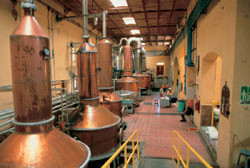 Tequila and mezcal: what's the difference?Despite the fact that tequila is a more refined alcoholic drink, mezcal still holds its own. It is still popular among Mexicans. Its adherents claim that it conveys the aroma of the plant better. There are local variations of mezcal made from different types of agave: sotol, bacanora and others, and in rural areas you can still try pulque. Since the mid-20th century, companies specializing in mezcal began to bottle the drink in square bottles with bright labels to attract the attention of buyers. Many sell them complete with a bag containing a mixture of salt and powder from dried Bombix agavis and Hypopta agavis caterpillars, which live in agave shoots. This mixture is used before drinking mezcal. Or even cooler - they put the carcass of a caterpillar in the bottle. During life, it is painted bright red, and quickly becomes discolored when preserved in alcohol. According to the etiquette of drinking mezcal, the caterpillar is divided equally between all participants in drinking the bottle. The main principles that distinguish peasant mezcal from noble tequila are the following: 1. Mezcal is made from different types of agave, which ripen faster, while tequila is made only from blue. 2. The fruits undergo heat treatment in ovens of different shapes and using different technologies, mezcal in narrow underground ones, tequila in round ovens located on the ground. 3. Tequila is a product of double, sometimes even triple distillation, while mezcal is single. 4. Mezcal is usually somewhat stronger than tequila - up to 40 degrees. Hot Cocktails You don't have to go to Mexico to taste tequila. In any bar in the world, starting in the 1980s - the time of the rise of interest in this drink - you will always be served golden tequila mixto. Cocktails based on it are especially popular: the very fact of the presence of this hot Mexican drink in them gives it a "drive". The most famous cocktail is Las Margaritas, the immortal and timeless "Margarita". The classic recipe looks like this: tequila (usually tequila mixto) with lemon juice and orange liqueur. Although in different bars around the world it can be slightly changed.
Tequila and mezcal: what's the difference?Despite the fact that tequila is a more refined alcoholic drink, mezcal still holds its own. It is still popular among Mexicans. Its adherents claim that it conveys the aroma of the plant better. There are local variations of mezcal made from different types of agave: sotol, bacanora and others, and in rural areas you can still try pulque. Since the mid-20th century, companies specializing in mezcal began to bottle the drink in square bottles with bright labels to attract the attention of buyers. Many sell them complete with a bag containing a mixture of salt and powder from dried Bombix agavis and Hypopta agavis caterpillars, which live in agave shoots. This mixture is used before drinking mezcal. Or even cooler - they put the carcass of a caterpillar in the bottle. During life, it is painted bright red, and quickly becomes discolored when preserved in alcohol. According to the etiquette of drinking mezcal, the caterpillar is divided equally between all participants in drinking the bottle. The main principles that distinguish peasant mezcal from noble tequila are the following: 1. Mezcal is made from different types of agave, which ripen faster, while tequila is made only from blue. 2. The fruits undergo heat treatment in ovens of different shapes and using different technologies, mezcal in narrow underground ones, tequila in round ovens located on the ground. 3. Tequila is a product of double, sometimes even triple distillation, while mezcal is single. 4. Mezcal is usually somewhat stronger than tequila - up to 40 degrees. Hot Cocktails You don't have to go to Mexico to taste tequila. In any bar in the world, starting in the 1980s - the time of the rise of interest in this drink - you will always be served golden tequila mixto. Cocktails based on it are especially popular: the very fact of the presence of this hot Mexican drink in them gives it a "drive". The most famous cocktail is Las Margaritas, the immortal and timeless "Margarita". The classic recipe looks like this: tequila (usually tequila mixto) with lemon juice and orange liqueur. Although in different bars around the world it can be slightly changed. On the American continent to strongThe Mexican drink is often served with "Sangrita", a non-alcoholic cocktail made from a mixture of tomato juice and orange juice. Tequila is also drunk neat, although with a certain "twist", contained in the formula: "salt", "tequila", "lime". There is a legend about where this came from. In 1930, when influenza was raging in Northern Mexico, a local doctor prescribed tequila with salt and lemon as a remedy for the deadly flu epidemic. Most likely, the doctor himself tried this pleasant combination on himself more than once and wanted to maintain the taste for life in patients with it. It should not be forgotten that in the old days, when tequila was still mezcal, its taste was rougher and its strength was higher than today. And so salt and lime were intended to distract the taste buds from the sharp taste of alcohol. The recipe caught on. There are many tequila connoisseurs who are convinced that salt and lime, like ice, grapefruit juice or a cigar, only distract from the true taste of the drink, which should not be drunk in one gulp, not covered up with ingredients, but savored, like cognac and old wine. "100 percent agave. Everything else will be superfluous," is the slogan of people who have dedicated decades of their lives to comprehending the taste of the legendary tequila.
On the American continent to strongThe Mexican drink is often served with "Sangrita", a non-alcoholic cocktail made from a mixture of tomato juice and orange juice. Tequila is also drunk neat, although with a certain "twist", contained in the formula: "salt", "tequila", "lime". There is a legend about where this came from. In 1930, when influenza was raging in Northern Mexico, a local doctor prescribed tequila with salt and lemon as a remedy for the deadly flu epidemic. Most likely, the doctor himself tried this pleasant combination on himself more than once and wanted to maintain the taste for life in patients with it. It should not be forgotten that in the old days, when tequila was still mezcal, its taste was rougher and its strength was higher than today. And so salt and lime were intended to distract the taste buds from the sharp taste of alcohol. The recipe caught on. There are many tequila connoisseurs who are convinced that salt and lime, like ice, grapefruit juice or a cigar, only distract from the true taste of the drink, which should not be drunk in one gulp, not covered up with ingredients, but savored, like cognac and old wine. "100 percent agave. Everything else will be superfluous," is the slogan of people who have dedicated decades of their lives to comprehending the taste of the legendary tequila.

Making Money with Desserts: Success Stories
Evgeniya Polischuk (Fedutinova) instagram:@evgeniyafedutinovavk.com/janeshomebaking– It all started with baking for family and friends. Gradually, I started posting photos of my baked goods on Instagram – and orders started coming in. I made my first custom-made cake on October 13, 2014, and a little earlier I started making macaroons and cupcakes. You could say that the business “found me”, I am very […]

Soups are cold recipes with photos
Cold cucumber soup with yogurt and lemonsorbet from the chef of the restaurant La Taverna Alexander Zhurkin Photo: Getty Images Ingredients: Plain yoghurt – 125 g Cucumber – 150 g Lemon/lime sorbet – 50 g Cocktail shrimp – 24 g Fresh ginger juice – 1 g Lime juice – 5 g Fresh orange juice – 5 g Parsley – 1 g Pink pepper – 1 g Watercress – […]

barbeque kebab
Pork tenderloin in glaze Photo:Dmitry Bayrak/dbstudioPreparation time: 20 minutes + marinating time.Calories: 454 kcal per serving.For 4 servings: 4 pork tenderloins (approximately 300 g each), 1 onion, 2 cloves of garlic, 1 tsp. lemon zest, 1 tsp. lemon juice, a pinch of ground cumin, coriander and turmeric, 1 tbsp. vegetable […]

Pierre Duacan: dietary recipes: Ducane diet
Beetroot soup Photo:Season’S, Luxury Hotels RepresentationYou will need:· Boiled beetroot – 60 g· Fresh cucumbers – 20 g· Red radish – 20 g· Green onions – 10 g· Egg – 1 pc.· Drinking mineral water – 200 g· Salt – 1 gPreparation:· Boil the egg and beetroot.· Grate the cucumbers, radish and part of the beetroot. Put everything […]


